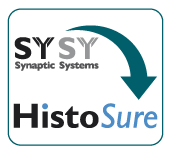|
Cat. No. HS-397 017BT
|
100 µg purified IgG, lyophilized, labeled with
Biotin.
Biotin is a small vitamin B complex molecule. Its small size minimizes interference with antibody binding sites and allows for efficient conjugation without compromising antibody functionality.
Biotin conjugated antibodies can be easily detected with Avidin/Streptavidin based secondary detection systems.
The streptavidin-biotin bond is one of the strongest non-covalent biological bonds known.
Albumin and azide were added for stabilization. For reconstitution add 100 µl H2O to get a 1mg/ml solution in PBS. Then aliquot and store at -20°C to -80°C until use.
Antibodies should be stored at +4°C when still lyophilized. Do not freeze!
|
|
Applications
|
WB: 1 : 500 (AP-Staining) gallery IP: not tested yet ICC: not tested yet IHC: not tested yet IHC-P: 1 : 100 gallery
Western blot (WB); separation of proteins by PAGE and subsequent transfer to a membrane. Detection of target molecules is carried out with antibodies. Some antibodies require special sample preparation steps. For details, please refer to the “Remarks” section.
Immunoprecipitation (IP); Immunoisolation or pulldown of a target molecule using an antibody. For details and product specific hints, please refer to the ”Remarks” section.
Immunocytochemistry (ICC) on 4% PFA fixed cells. Immunoreactivity is usually revealed by fluorescence. Some antibodies require special fixation methods. For details, please refer to the “Remarks” section.
Immunohistochemistry (IHC) on 4% PFA perfusion fixed tissue with 24h PFA post fixation. Immunoreactivity is usually revealed by fluorescence or a chromogenic substrate. Some antibodies require special fixation methods or antigen retrieval steps. For details, please refer to the ”Remarks” section.
Immunohistochemistry (IHC-P) of formalin fixed, paraffin embedded (FFPE) tissue (some antibodies require special antigen retrieval steps, please refer to the ”Remarks” section). Immunoreactivity is usually revealed by fluorescence or a chromogenic substrate.
|
|
Label
|
biotin
|
|
Clone
|
167B3
|
|
Subtype
|
IgG2a (κ light chain)
|
|
Immunogen
|
Synthetic peptide corresponding to residues near the amino region of mouse F4/80 unprocessed precursor (UniProt Id: Q61549)
|
|
Reactivity
|
Reacts with: mouse (Q61549).
Other species not tested yet.
|
|
Data sheet
|
hs-397_017bt.pdf
|
 Important information
Important information